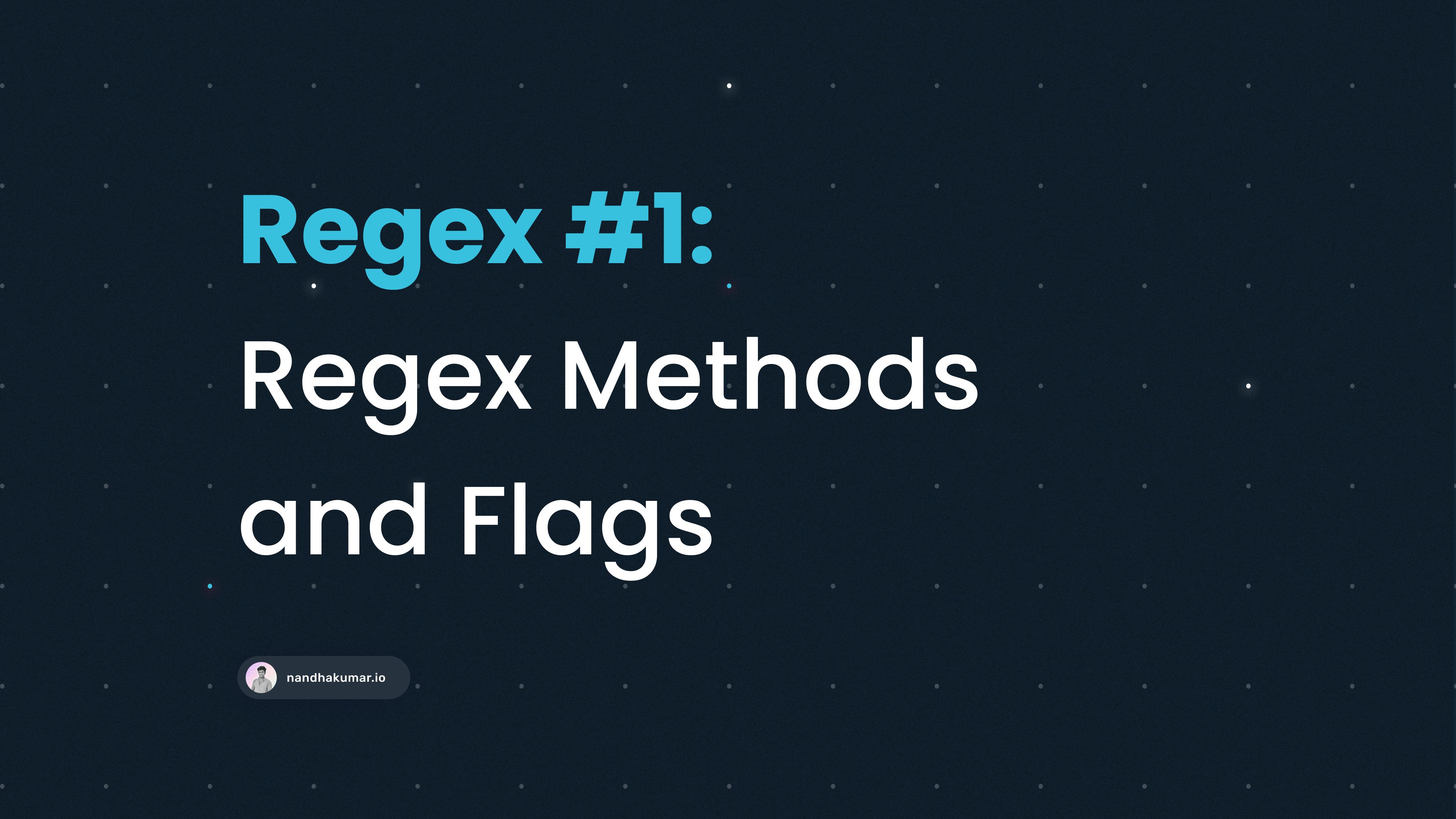Jan 4, 2023
5 min read
Regex #1: Understanding Regex, Regex-Based String Methods and Regex Flags
#javascript
#typescript
#regex

Hi There! 👋
In this post, you will learn the fundamentals of regex.
Why Regex?
The most common feature every application has is user registration and login.
Nowadays, Libraries(Eg: Class Validator NPM Package) that you use for form validation has a direct method to validate input value like isEmail(), etc...
Which is very helpful, But each application has its own use case. So, these direct methods won't be helpful in that case.
For Example, Not all application has the same rules for password.
In such scenarios, you can use Regex Pattern to validate the user input values.
Note: Regex is not limited to use only for Input Validation
Most of the time I used to find the required Regex pattern from Google.
At some point, I thought why can't we try to understand regex instead of searching on Google?
Just gave try!
After understanding some basics, Regex was interesting. And I regret that I didn't learn Regex so far.
That's How I started learning Regex in depth.
Note: Examples I share in this post are based on javascript, but the concepts can be applied to any programming language
Defining a Regex Pattern?
When you add a pattern between /, it is considered a regex pattern
/[regex pattern]/Note: There shouldn't be any
'or"around the/
Two Ways to test Regex Pattern
Using Regex Methods
.test() - It will return a boolean value if the pattern matches the string
// regex Pattern
const pattern = /world/
// string to be tested against the pattern
const text = 'Hello world'
// returns 'true' as the 'world' is present in the message
console.log('[Test Method] - ', pattern.test(message))
}// output
[Test Method] - true .exec() - It will return an array with the index and additional info on the matching pattern
// regex Pattern
const pattern = /world/
// string to be tested against the pattern
const text = 'Hello world'
// returns Array with index and additional info
console.log('[Exec Method] - ', pattern.exec(message))
// output
[Exec Method] - [ 'world', index: 6, input: 'Hello world', groups: undefined ] Using String Methods
.match() - It will return an array with the index and additional info on the matching pattern (similar to .exec() method) if only one match is found. Otherwise, it will return all the string that matches the pattern as an array.
// regex Pattern
const pattern = /world/
// string to be tested against the pattern
const text = 'Hello world'
// returns Array with index and additional info
console.log('[Exec Match] - ', text.match(pattern))
// output
[Exec Match] - [ 'world', index: 6, input: 'Hello world', groups: undefined ] .replace() - It will replace the string that matches the pattern with the string that is to be replaced.
// regex Pattern
const pattern = /world/
// string to be tested against the pattern
const text = 'Hello world'
// returns Array with index and additional info
console.log('[Exec Replace] - ', text.replace(pattern, 'Word'))
// output
[Exec Replace] - Hello Word.split() - It will split the text into an array based on the matching pattern
// regex Pattern
const pattern = /world/
// string to be tested against the pattern
const text = 'Hello world'
// returns Array with index and additional info
console.log('[Exec Split] - ', text.split(pattern))
// output
[Exec Split] - [ 'Hello ', '' ]Regex Flags
There are three 3 flags in Regex
g - Global
Usually, when you try to match a pattern, it will match only the first occurrence in the string.
By adding the Global flag to the Regex pattern, it can match multiple occurrences of the pattern in the string
// regex Pattern with global flag
const pattern = /the/g
// string to be tested against the pattern
const text = 'Get the Work Done and the work will pay off.'
// Returns Array of strings matching the pattern
console.log('[Exec Global Flag] - ', text.match(pattern))
// output
[Exec Global Flag] - [ 'the', 'the' ]i - Case Insensitive
By default, matching string with regex is case-sensitive.
By adding the Case Insensitive flag to the Regex pattern, it can match the string with Case Insensitive
// regex Pattern with global and Case Insensitive flag
const pattern = /work/gi
// string to be tested against the pattern
const text = 'Get the Work Done and the work will pay off.'
// Returns Array of strings matching the pattern
console.log('[Exec Global & Case Insensitive Flag] - ', text.match(pattern))
// output
[Exec Global & Case Insensitive Flag] - [ 'Work', 'work' ]m - Multi Line
When you try to match a pattern with a multi-line string, By default the match is found only in the first line even though we have a match in the second line
By adding the Multi Line flag to the Regex pattern, it can find the matches in multiple lines.
// regex Pattern with global and Multi-Line flag
const pattern = /^The/gm // starts with "The"
// string to be tested against the pattern
const text = 'The the Work Done.
The work will pay off.'
// Returns Array of strings matching the pattern
console.log('[Exec Global & Multi Line Flag] - ', text.match(pattern))
// output
[Exec Global & New Line Flag] - [ 'The', 'The' ]